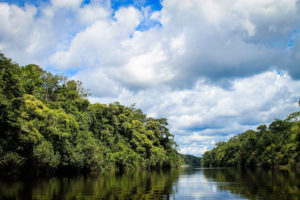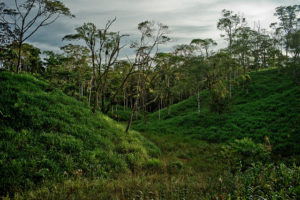
Views on ecological restoration in the Andes of Colombia, Ecuador, Peru and Bolivia.
The tropical forests of the Andes in Latin America are key global ecosystems that make an extraordinary contribution to the world’s biodiversity and livelihoods. Andean forests are the source of huge rivers, and have more varied and unique species than the Amazon. But they are now are threatened by increasing demographic pressures, and by harvesting and production practices.
In the past decade, ecological restoration has become a vital strategy to recover the integrity and functionality of degraded ecosystems, to promote sustainable development, and to mitigate climate change.
Colombia, Ecuador, Peru and Bolivia — the countries hosting tropical Andean ecosystems — have each set quantitative restoration targets. But what has been the real progress in these countries? And what is happening to their Andean forests?
To understand developments in tropical Andean forest restoration, the Center for International Forestry Research (CIFOR) and the Andean Forests Program — a regional initiative of the Swiss Agency for Development and Cooperation (SDC), facilitated by a partnership between Helvetas Swiss Intercooperation and Condesan — undertook a comparative analysis to look at the progress, challenges and future prospects of Andean forest restoration in these four countries.
Over a period of 14 months, researchers examined academic, legal and policy documents and conducted more than 40 interviews. Their aim was to identify challenges and opportunities to guide the next steps in restoration policy and practice for Andean forests. The resulting analysis will prove essential in making the most of “unprecedented” levels of international attention and funds, says Manuel Guariguata, co-author of the study and leader of CIFOR’s Forest Management and Restoration Team.
“It is now essential to start the restoration process,” says Carolina Murcia, a senior researcher affiliated with the Pontifical Xavierian University in Colombia and lead author on the study. “We can’t afford to lose more natural capital; rather, it is time to start recovering it.”
Read more: Lessons from Latin America for forest landscape restoration

DIFFERENT APPROACHES
A key finding of the study is heterogeneity among Andean forests. “Each of the four study countries has its own history, geography and socioeconomic situation, which determine its relationship with Andean forests and the restoration approach,” says Murcia.
Colombia is leading the movement, with 50 years’ experience in restoration and a historical focus on these forests: the Andes are home to 75% of country’s population, but are also fertile lands and a major source of its water. In addition, 70% of Colombia’s electricity is generated by water flowing through these forests.
The National Plan for Forest Restoration of Ecuador, for its part, identifies two priority criteria for fertile Andean areas: landslide prevention and water resource protection.
Meanwhile, the relationship of Peru and Bolivia to Andean forests is completely different. In Peru, these ecosystems, known as yungas, or “high rainforests”, originally covered 15% of the nation’s territory. With steep slopes and high moisture levels, they are seen as an area of passage to the Amazon. “In this region, all forests are often seen as ‘rainforests’ and are considered for harvesting purposes as a source of timber. Thus, restoration has also played a very discreet role,” says Murcia.
In Bolivia, there are large forest areas with low population density. According to the study, this “has resulted in a culture of abundance, where the notion of restoration does not even fit.” The current philosophy of the state, for example, “does not allow forest restoration outside a production scheme,” Murcia says.
Strangely, local people who have occupied the Bolivian highlands for decades are not aware of the disappearance of their forests. The study reveals that “the scarcity they may experience in periods of drought is not associated with loss or, therefore, restoration.” According to Murcia, all this shows why restoration is still in the early stages in Bolivia and Peru.
This heterogeneity in approaches to restoration is reflected in aspects such as policy frameworks, implementation mechanisms, and the links between decision-makers, biological resource managers, academia and civil society.
COMMON CHALLENGES
In spite of the differences, the four countries also face common challenges. The first is to integrate a new, holistic discipline such as ecological restoration into government policies ranging from natural resource management to development. Restoration, says Murcia, means much more than increasing forest cover and capturing carbon.
An additional challenge is to comply with international restoration commitments through national programs but with local implementation — something difficult when technical capacity, technology and information are limited.
Other challenges? One is the lack of a common definition. “What restoration means for one sector may not mean the same to another,” says Guariguata, mentioning the tasks of assessing the success or failure of programs, and meeting international targets such as the Bonn Challenge. In his view, there is also a need to develop a unified vision of the discipline, which is currently fragmented into sectors such as environment, agriculture and indigenous peoples.
Restoration is a long-term process, which can take from six to ten decades to consolidate. Success, says Murcia, cannot be achieved without community commitment, and structures for management and budgetary administration that go beyond presidential terms and “protect initiatives against political whims.”

NEXT STEPS
Although one of the international targets of the Convention on Biological Diversity, known as Aichi #15, is to restore 15% of the ecosystems degraded by 2020, the study sets a more realistic objective: each country should start from this commitment, ensuring that in 50 years these ecosystems will be on an appropriate path of restoration for biodiversity. This means recovering the variety of species, not recovering the land for production purposes, says Murcia.
To achieve community commitment, she considers it essential to secure land tenure and to report both the effects of degradation of forest landscapes and the benefits of their recovery.
“Restoration works! What needs to be done is to guide communities and understand the social and economic drivers of degradation,” she says.
In addition, the participation of the academic sector and NGOs in program design needs to be strengthened. Verónica Gálmez, Andean Forests Program incidence coordinator, explains that “NGOs act as hinges between local and national actors and provide an overall view of territorial and sectoral levels.”
According to Gálmez, the study can help prioritize interventions and investments and determine baselines. Thus, dissemination actions are planned for the various countries.
Murcia, like Gálmez, views the future with optimism. The reason? Communities’ growing interest in recovering their forested landscapes. “In the end, restoration is much more than planting trees. It is about turning the relationship between people and nature into something positive.”
By Gloria Pallares, originally published at CIFOR’s Forests News.
For more information on this topic, please contact Manuel Guariguata at m.guariguata@cgiar.org or Carolina Murcia at carolinamurcia01@gmail.com.
This research was prepared by CIFOR and the Andean Forests Program, facilitated by Helvetas Swiss Intercooperation and Condesan and financially supported by CIFOR through the CGIAR Research Program on Forests, Trees and Agroforestry, which is supported by CGIAR Fund Donors, and by the Department for International Development (DFID) through the KNOWFOR program. The Andean Forests Program is part of the Global Programme on Climate Change of the Swiss Agency for Development and Cooperation (SDC).











